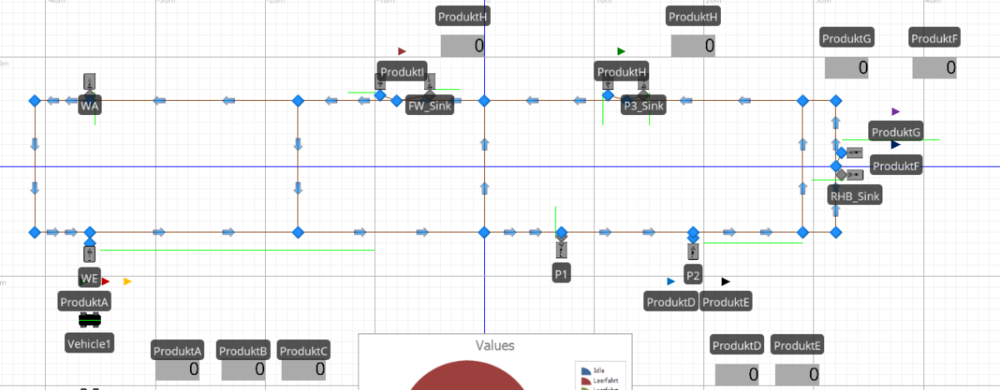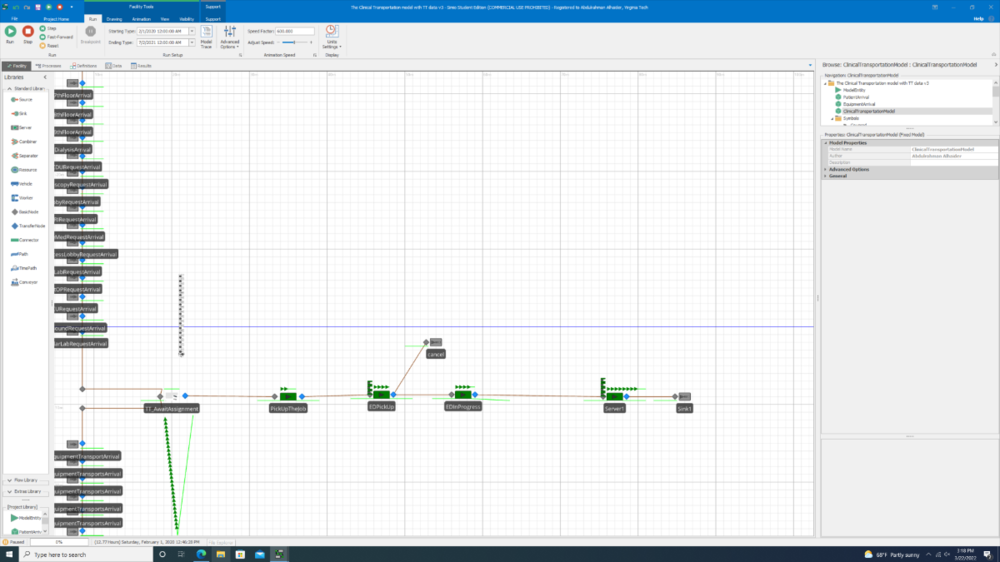Search the Community
Showing results for 'sink percentage of entities'.
-
How to increase the distence between entity to entity ?
ViniciusF replied to River's topic in SI General Discussions
To make an entity wait until the runway is free what you could do is set the Initial Traveler Capacity of the Runway path to 1. This way entities will wait at the node before entering the path. I did not understand the first question, but if you need entities to visually appear behind one another, set Allow Passing to False on the path. Alternatively, you could use conveyor instead of path to make entities allign and respect some distance. Hope it helps. -
Hello! So I am using a source that is sending out 9 different entities, each with a priority 1-9. They are listed in a Data table called 'Part Data' This is the 'Table Row Referencing' call I am using in 'Before Creating Entities' in the 'Row Number' section: PartData.Priority.RandomRow I want to switch this to use a Random.Normal(mean, sd) - is that possible with discrete values in the table? Thank you for any help you can provide!
-
I used rate tables once, these events per hour does not guarantee that you'll have that amount of entities on the time interval. It varies from replication to replication. Sometimes you'll generate less, sometimes more.
-
Hi All, I want to do some calculations just before the simulation ends. I did it previous versions without problem but now on version 15.247, "on run ending" add-on process is not being executed.I tested it even on a new simple model file with source server sink. There is just two assign steps with breakpoints on the add-on process. But in model trace it doesnt show the add-process name, the state variable value is not assigned, and breakpoint is not reached. Anyone experiencing the same problem in this version? Is there a quick solution to this? Or do I have to install older version? Kind regards, Tolgahan
-
Hi, A Separator is creating copies of the entities that enter it, the number of copies depends on a probability distribution, I want the worker to transport all the entities created from the same parent entity at once. Is this possible? I attach the model for better understanding. Thank you so much! Model.spfx
-
Generating new entinty in combiner
Khaled Khamis replied to xdabroar's topic in SI General Discussions
Hi, A combiner is able to combine 1 or more entities into a parent entity. The number of entities that are batched together is specified in the property Batch Quantity. I recommend looking at the SimBit "Combine Multiple Entity Types Onto Pallets" for an example. Best, Khaled -
hello i'm the simio user in south korea i want to make my model flexibily. My model has vehicle and elevator The overall process flow is vehicle take entities to server1, After vehicle arrived to server1, elevator take entities and go to every destination. To work well, Three things are needed for this trend First, i want to do if the vehicle comes to server1 then the elevator goes to upstair Second, the vehecle has to wait until the elevator after been to upstair and arrive to server1 Third, repeat the two steps. how can i solve the problem this model in Model2, not Model1 1veh1eleModel.spfx
-
Thank you very much for your help, but simio says I can't use the Release step with the server because I don't have any resources to release. In addition, although the Search step works very well, since I don't have any step that keeps the entities inside the server even if they are not called, they continue to leave the server and merge with entities that should not be merged. If I set the processing time to infinity, despite calling entities with the Search process, the entity does not leave the server. I tried to condition the processing time of each entity according to the "Ventana_de_entrega" state, but as expected, it is not the most appropriate. 21.10.spfx
-
Hi There, I have lots of experience in simulation but I'm new to Simio - my apologies if my Simio vocabulary/conceptualization is off or if this question has been asked already. I'm working to build a queue model simulation with a network of services and multiple staff types. In my mind, it makes the best sense to do this using the standard library of servers and resource pools (to visualize the network for stakeholders and be able to model multiple staff with different schedules that can each respond to multiple services). Right now, I am starting with a single stage M/M/c type queue to make sure that my implementation is correct before scaling this upwards. I checked out the SimBit titled 'Source – Server – Sink' that has three different M/M/c implementations; however, none of them use Resource Pool objects or combine process triggers with the standard library. I was able to implement a basic model that tries to combine a resource pool with a server by triggering separate Seize and Release process triggers on entry to the server object and after the processing time is completed, respectively. It runs without error; however, the results for average time in system (calculated by an average of a tally statistic that is only recorded for every 500th customer/entity), the results are one third less than in a scenario where I don't use a resource pool and set the capacity of the server explicitly, (which I validated against M/M/c formulae results). Does anyone have tips for how to link servers and resource pools and troubleshoot this scenario? Is there a SimBit or other example out there that is relevant? Am I triggering the seize/resource processes at the wrong points in time? Or is my framework for how to conceptualize this in the Simio environment missing a key concept? Thanks!!
-
Well, first thing, you don't need your entities to be bouncing between the output and the input of your server like that. If you want to use it as sort of storage, set both the processing time and the capacity to infinity. After that, at the moment that the parent entity enters the combiner "Parent Entered" you could search the queue of your storage using a search step with something like "Server1.Processing.Contents", with the condition of "Candidate.ModelEntity.State == ModelEntity.State", release the server and transfer what have been found to the output. You need to take some care on some situations, like what if the parent entity arrives first at the combiner then the member at the storage? And some care with batching quantities aswell. But I think you can handle it.
-
Hi! In my model I have entities called "Pedido" which have a state called "id_del_pedido" which is equal to the ID of the entity. These entities will enter a Separator that will create copies of the entity according to a probability distribution. Since the new entities are copies of the parent entity, they will have the same "id_del_pedido" status as the parent entity. Subsequently, the entities created will enter a Server that acts as a warehouse. This Server is linked to a Combiner, when the parent entity reaches the Combiner's parentinput I want only entities whose "id_del_pedido" is equal to the ID of the entity that reached the Combiner's parentinput to leave the server. This works perfectly in the first Server-Combiner set of my model, but, the Combiner's outputnode is attached to another Combiner and I want to repeat the same activity as in the first Combiner but I get an error that I don't know how to solve. I attach my model so that my problem is better understood. Thank you very much in advance! 18.10.spfx
-
Hi! can you help me please? In my model I have a server that I want to function as storage, this server is linked to a combiner which will combine the member entities that leave the server with a parent entity that will arrive at it from another node. Each member entity has a state with a unique number linking it to a parent entity (there may be more than one member entity with the same state number). How can I extract from the server only the member entities whose state is equal to the state of the parent entity that arrives at the parentinput of the combiner? Thank you so much! 18.10.spfx
-
Hello Everyone, please can someone help me with this situation? I want to use a Server as a storage place, entities coming out of it go into the MemberInput of a Combiner. I want the number of entities that leave the Server to depend on the state of the entity that will enter the ParentInput of the Combiner. How can I access the state of the parent entity that will enter the combiner from the Output Node of the Server? Thank you very much, Greetings! 14.10.spfx
-
I want to build a simple repository model,as the Picture below. And there are two Funktions, that i donn't know, how to implement. The first Problem is: I hope that several products with different total amount can be generated in sequence one by one. For Example, there are 50 Product A, 40 Product B and 30 Product C at Source WE. They schould be generated in sequence. First 50 Product A,1,2,3...50 one by one generated. Then 40B, generated one by one and finally C. At present, I can only achieve one-time generation of all A, then all B and All C. The second Problem ist: there are may be 10 Vehicles in the System. I want to record the total time of the car loaded and empty travel time, and the corresponding percentage of these two items. I would be very very grateful if you could help. I'm really in a hurry and hope to get your help.
-
Hello, I'm working on a problem where at some point a worker will transport a specific amount of pallets. Whereafter these pallets are processed by a server and a server wil process them. Once processed, a different worker (or the same worker) will move the pallets to the next server. How do I save these entities as a batch and let workers know how much pallets they can process? At the moment I have two approaches. One where I create a 'batch' as an entity and assign to it the amount of pallets. The 'problem' in that case is that I do need to count the amount of pallets at a server, since it has a certain capacity. And sometimes an initial batch whitch comes from a truck needs to be split to fit the capacity of workers. But once this would be fixed, the worker will always transport the right amount of pallets. A second approach that I have tried is to create the pallet entities normally, and assign a 'PalletHistory' in the modelEntity properties, but I find that after processing I can't find this palletHistory for the workers to get a sign of how many pallets to transport. Do any of you guys have an idea how I can approach this? Greetings
-
I think if you set the max to 30, if 14 are generated all 14 (or other <30 number) will enter the workers ride queue and will be transported. You could also keep the ride capacity at 1, model the 14 pallets as 1 entity (lets call this a shipment entity), have the worker move that 1 entity to the next location, and then use a separator to turn the shipment entity into some number of pallet entities. Attached is an example. example 9.23.22.spfx
-
I wonder if it is possible to pick one particular entity from the BatchMembersQeue and unbatch it. For example I have a pallet with 10 entities batched (9 red and 1 blue) and I want to remove only the blue one. I was able to find the entity with a search step, but I cannot transfer it or unbach it. Any ideas? TnksUnbatch one entity.spfx
-
Hi, I have an issue related to workers going off-shift and abandoning the reserved entities in different servers, depending on when the shift change happens (picture attached is an example). The shift change is based on switching from Worker of x number of population to y number of population to meet my WorkSchedule. The Worker should always carry different entities throughout, entities cannot travel alone. The logic issue happens as a result of entities left in servers or buffers that were not picked up by workers due to the end of shifts, causing too many objects/entities in the system not destroyed. An expert suggested to build process that checks the Worker's Allocation Queue when it goes off shift to see if there are any entities in it, and if there are, turn the Worker back on shift. I tried to build that process, but I could find the right steps. Any help on identifying the right steps or a different way to model workers shifts is appreciated.
-
Entities in a buffer at the start of the simulation
gocken replied to Ondrej's topic in SI General Discussions
Try the logic included in this model. Note that you can use the same logic at any time over the simulation run. In this specific example the entities are created at the begining of the simulation run. If you need to create them at any time over the simulation run then you should define a seperate process then embed the same logic into that process. Then, all you need is to trigger that seperate process. For example, you can trigger by using timer element. Hope it helps?. CreateEntities.spfx -
Greetings, I would like to know if there is a way to include the volume of the entities into the vehicles capacities ? E.g. let's say that i have 5 entities with different volumes, and the vehicle has the capacity to transport X m^3, how can i include this in simio ? Best regards,
-
Hello everyone, I have a simple production line of 15 servers, some combiners, nothing too complicated. I need to somehow setup the input buffer at each server to have 1 entity at the start of the simulation and then run it. Or having filled servers with 1 entity at each server. Could anyone please help me and show me how to set it up? I need to start counting the stats once all the workstations are filled, but warmup period does not seem to work for that case, because it destroys the enitities at the servers and starts over. The filled-input-buffer-way looked to me like the easiest solution. But if there is another way, please let me know. Thank you!
-
I'm interested in calculating a yearly production rate. Essentially I could do this if I ran my simulation for 1 year and looked at the output. The number of entities destroyed by my "completed" sink will be what I'm looking for. How do I determine this value if I'm running for longer than 1 year? For example; If I run for 5 years, and I'm watching my model run, at week 186 I'd like to know how many entities had been destroyed by my "completed" sink between weeks 134 and 186 to determine my yearly production rate.
-
Hi, I have a bottleneck at the end of my assembly line. I cannot dupplicate that station as my total number of workers is already high. Before hiring, I would like to try and reallocate and have satellite employees. I want to allocate my workers to that station when the input buffer has exceeded one entity. Every worker has to finish the entity they are presently working on at the other stations and the first workers that are done need to go the bottleneck station. The rest of the time, the workers can be allocated based on the smallest distance to the work stations. The bottleneck station usually requests 4 workers. That information is already set up in a table. When there is two entities in queue in that buffer, I want workers to be able to go finish the work and hence increase the processing time by X. I have tried a lot of different things, and all my data is stored in relational tables. Thanks!






